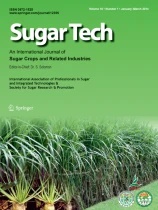Ver ítem
- xmlui.general.dspace_homeCentros Regionales y EEAsCentro Regional Salta - JujuyEEA SaltaArtículos científicosxmlui.ArtifactBrowser.ItemViewer.trail
- Inicio
- Centros Regionales y EEAs
- Centro Regional Salta - Jujuy
- EEA Salta
- Artículos científicos
- Ver ítem
Carbon Dioxide and Nitrous Oxide Emissions from a Typical Sugarcane Soil in the Cauca River Valley, Colombia
Resumen
Sugarcane is an important crop for tropical countries and to accurately inventory its greenhouse gas (GHG) emissions baseline measurements are needed. In Colombia, sugarcane is one of the most important crops in terms of cultivated area and, paradoxically, scientific information reporting GHG emissions based on field measurements is almost nonexistent. The objective of this work was to quantify the direct emissions of carbon dioxide (CO2) and nitrous
[ver mas...]
Sugarcane is an important crop for tropical countries and to accurately inventory its greenhouse gas (GHG) emissions baseline measurements are needed. In Colombia, sugarcane is one of the most important crops in terms of cultivated area and, paradoxically, scientific information reporting GHG emissions based on field measurements is almost nonexistent. The objective of this work was to quantify the direct emissions of carbon dioxide (CO2) and nitrous oxide (N2O) in the sugarcane-soil system of the Cauca river valley, Colombia. For this purpose, a field experiment was established in a typic haplustert soil cropped with sugarcane. The effects of nitrogen (N) fertilization and sampling site on its GHG emissions were tested using the closed static chamber method over a period of 211 days. The main cumulative emissions were 765.14 ± 34.1 g CO2–C m−2 and 125.4 ± 22.6 mg N2O–N m−2. Overall, GHG emissions were modified by N fertilization, the sampling site, and their interaction. Nitrogen fertilization with urea increased mean and cumulative CO2 and N2O emissions, especially at the row sampling site. This paper highlights the importance of considering these factors when the quantification of GHGs or a reduction of their associated uncertainties are required. This work reportss the first GHG emissions data for a typical sugarcane agroecosystem in Colombia.
[Cerrar]

Autor
Valencia-Molina, Manuel C.;
Chalco Vera, Jorge Elías;
Loaiza, Sandra;
Trujillo, Catalina;
Munera, Bryan;
Castro-Franco, Mauricio;
Silva-Parra, Amanda;
Chirinda, Ngonidzashe;
Muñoz-Arboleda, Fernando;
Fuente
Sugar Tech 26 : 171-179. (February 2024)
Fecha
2024-02
Editorial
Springer
ISSN
0972-1525
0974-0740
0974-0740
Formato
pdf
Tipo de documento
artículo
Palabras Claves
Derechos de acceso
Abierto
 Excepto donde se diga explicitamente, este item se publica bajo la siguiente descripción: Creative Commons Attribution-NonCommercial-ShareAlike 2.5 Unported (CC BY-NC-SA 2.5)
Excepto donde se diga explicitamente, este item se publica bajo la siguiente descripción: Creative Commons Attribution-NonCommercial-ShareAlike 2.5 Unported (CC BY-NC-SA 2.5)


